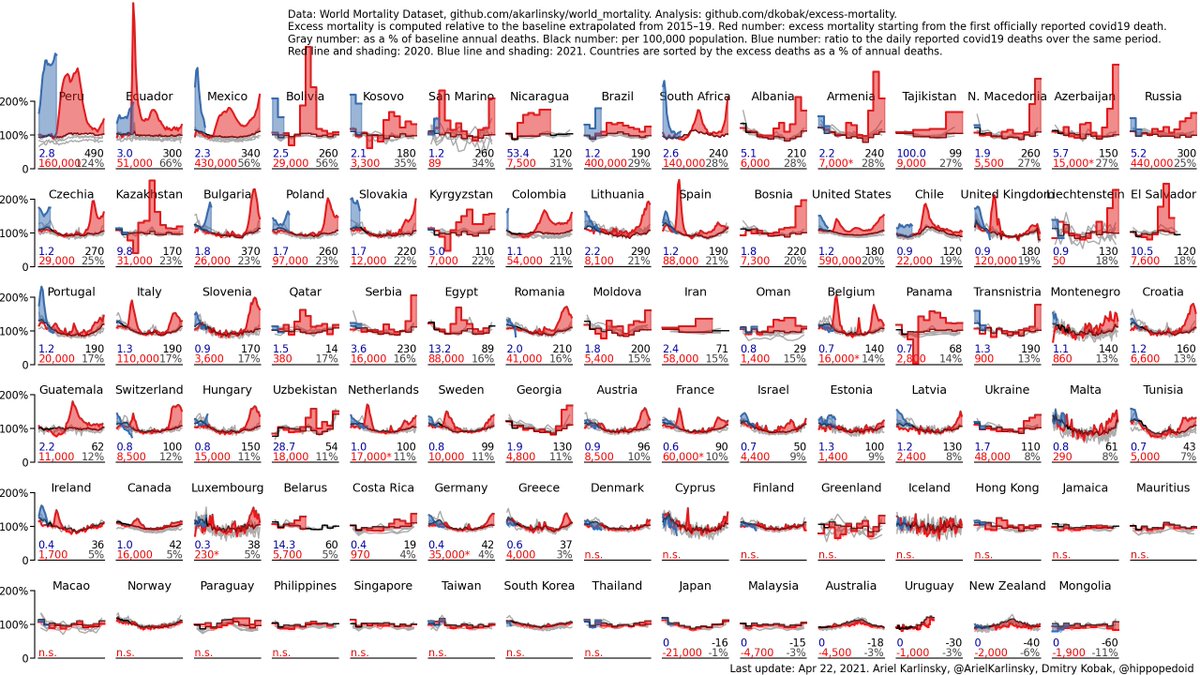
Our report on the largely unobserved COVID-19 epidemic in Damasucs was just published in @natcomms.
I don't like sharing my publications but this one I a really proud of. Why? Well over a year has passed and it still is shocking how much mortality has been missed. A Thread
I don't like sharing my publications but this one I a really proud of. Why? Well over a year has passed and it still is shocking how much mortality has been missed. A Thread
https://twitter.com/MRC_Outbreak/status/1385188994661617668
The results have not massively changed since the initial report last September. For an overview see:
https://twitter.com/ojwatson92/status/1305939091612225537?s=20
The main difference is we used the Facebook obituary notifications data set again to show that the "uptick" in mortality reported during Winter 2020 was not accompanied with a large increase in excess mortality.
This is most likely due to:
1. Substantial immunity after the first wave limiting the size of second wave.
2. Better testing improving what proportion of deaths are recorded.
1. Substantial immunity after the first wave limiting the size of second wave.
2. Better testing improving what proportion of deaths are recorded.
However, this study was the first to change how I view COVID-19 mortality reporting. The current toll of >3 million deaths is a considerable under-estimate and I suspect it is closer to 10 million than 3 million. Why?
1. Excess mortality in areas we have it are pretty convincing of large levels of under-reporting, with often countries with very high reported burden (Latin America, South Africa, Russia) reporting between 1 in 5 to 1 in 2 deaths. 

Also important to highlight here that unreported COVID-19 mortality occurs in all income settings. Spain, USA, Portugal, Italy all had missed COVID-19 mortality at the beginning of their epidemics.
2. Locations that don't have excess mortality, often lower income settings, are showing anywhere between 1 in 100 and 1 in 10 deaths being reported at the peak of epidemics. These estimates also require considerable investigative efforts leveraging novel data source. E.g:
- Satellites of cemeteries in Aden, Yemen: 1.25% deaths reported. medrxiv.org/content/10.110…
- Social media surveys of symptomatic prevalence in combination with molecular and serological surveillance in Khartoum, Sudan: 3% (2% - 5% range) deaths reported. imperial.ac.uk/mrc-global-inf…
- Postmortem PCR for COVID-19 infection in Lusaka, Zambia. ~8% deaths reported. Importantly 72.8% of deaths occurred in the community and not in a healthcare facility. None of these deaths were tested. Only ~1/4 in facilities were tested. medrxiv.org/content/10.110…
- COVID-19 Funeral burial patterns in Jakarta, Indonesia. 25% deaths reported. medrxiv.org/content/10.110…
Why share all this gloom? Because it is really heartbreaking to see the situation in India unfold, with crematorium reports showing massive gaps between reported deaths and COVID-19 cremations:
https://twitter.com/jburnmurdoch/status/1384782984138694658?s=20
And yet only a few months ago, there was a really unhelpful discussion occurring where the end of India's first wave was being used as an example of baffling scientists and to draw a contrast against Western epidemics - likely contributing to complacency and the current wave.
But there was evidence of under-reporting in the first wave. Anywhere again between 1 in 5 (
https://twitter.com/VaccineEpi/status/1379791840573030408?s=20) to 1 in 2 deaths (bbc.co.uk/news/world-asi…) were reported during the first wave, which help explain the epidemic. See also
https://twitter.com/muradbanaji/status/1383012099606122498?s=20for IFR/sero
COVID-19 coverage has become increasingly political and country comparisons have been frequently used to essentially shame governments and place blame. But they have created a very toxic environment where attention is diverted away from actually understanding the true burden.
And why is that damaging? I fear that future investment in health surveillance will be based on official reported COVID-19 deaths, further widening the gap in health surveillance. We have already seen the moral failure in terms of global vaccine allocation.
And roll on the next pandemic we will be having the same toxic debates, again with no data to show where transmission is really occurring, how severe the pandemic is in different regions and where vaccination needs to be prioritised.
But now for an optimistic finish. There are data sources out there. This Damascus study was only possible because of community led initiative of uploading obituary notifications to Facebook. Citizen science approaches combined with social media etc can help bridge the data gap.
Alternatively operations such as collating gravedigger burials to create new mortality data sources can help increase coverage of mortality statistics, e.g. in Addis Ababa reuters.com/article/us-hea…
And the Yemen study linked above is such a cool use of satellite imagery to estimate changes in burial patterns and is something that could easily be scaled and automated. Investing in these remote sensing approaches needs to happen to close the info gap. medrxiv.org/content/10.110…
• • •
Missing some Tweet in this thread? You can try to
force a refresh


